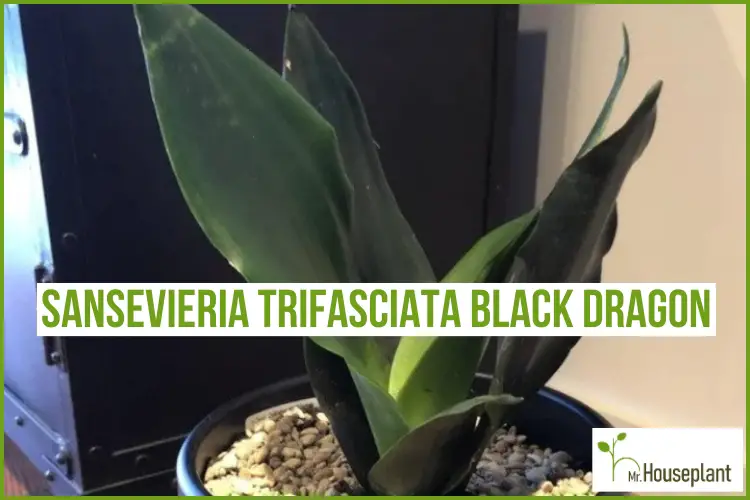
Would you like to grow a Sansevieria Trifasciata Black Dragon but don’t know where to start? How to care for Black Dragon, or how to prune and fertilize it? Then this full guide is the perfect read for you. Read on to get all the care tips from light and water requirements to propagation, pruning, and common problems.
Sansevieria Trifasciata Black Dragon is a compact snake plant with dark green leaves. Black Dragon is a common name for Sansevieria Trifasciata ‘Future Midnight’, as well as for plants grown through leaf propagation of Sansevieria Trifasciata ‘Sheri’.
‘Sheri’ is a variegated snake plant, but its leaf propagations do not keep the variegation and grow dark green leaves known as ‘Black Dragon’.
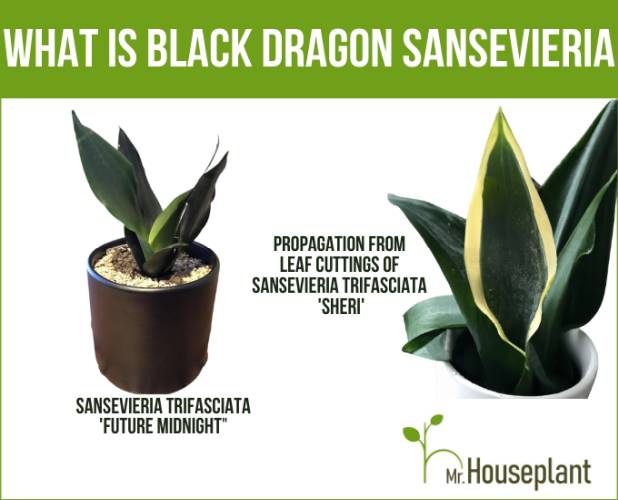
Future Midnight and Sheri propagation
| Botanical Name (Latin Name/Scientific Name): | Sansevieria Trifasciata ‘Future Midnight’, Sansevieria Trifasciata ‘Sheri’ |
| Common Name: | Sansevieria Black Dragon, Black Dragon Plant, Snake Plant, Black Dragon |
| Light: | low light tolerant |
| Watering: | when the soil dries out to the bottom of the pot |
| Soil: | succulent or cacti mix |
| Repotting: | Once a year |
| Fertilizing: | once every 2-4 weeks with a succulent fertilizer |
| Temperature: | 18 to 24 C° (65 to 75 F°) |
| Humidity: | optimal 5% to 25%, but adapts well to any humidity level |
| Toxicity for Pets: | Toxic to cats and dogs (nausea, vomiting, diarrhea) |
| Toxicity for Humans: | Toxic (vomiting, diarrhea, dermatitis |
| Propagation: | Leaf cuttings in water/soil, division, and rhizome cuttings. Leaf cutting of ‘Sheri’ |
| Pruning: | Prune dead or diseased growth |
Sansevieria Trifasciata Black Dragon Care
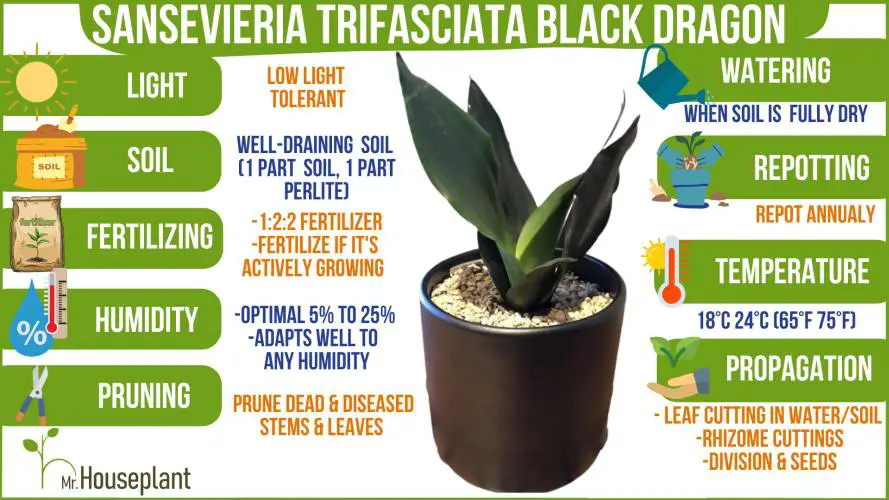
Sansevieria are considered low-maintenance plants, however, make sure to follow the care requirements
Light Requirements
Sansevieria Trifasciata Black Dragon prospers in medium indirect light (light over 750 lux or 75 foot candles). It tolerates 5-6 hours of direct sunlight daily. If you can’t provide these light levels, this plant can also live in lower light, (50 lux), but the new growth will be thin and elongated. More light means a happier plant. Light increases photosynthesis and makes the plant more resistant to diseases and pests.
| Minimal amount of light: | 50 lux (5 FC) |
| Optimal amount of light: | 750+ lux (75+ FC) |
| Direct sun tolerance: | 5-6 hours |
| Category: | low-light tolerant |
Can Sansevieria Trifasciata Black Dragon Tolerate Very Low Light?
Yes, Sansevieria Trifasciata Black Dragon can tolerate very low light (as low as 50 lux). It will survive, but it will not prosper. In low light new growth will be small and spindly and the foliage will become stretched or elongated. Provide medium indirect light (light over 750 lux) to make sure that the plant is healthy and beautiful.

Place your plant in front of a window and increase light by up to 10 times
Water Needs
Water Sansevieria Black Dragon once the soil is completely dry to the bottom of the pot. Use a chopstick to check the soil. Insert the chopstick inside the soil, push it lightly all the way down, and then pull it out. If the chopstick is dry, with no soil sticking to it, you can water the plant. On the other hand, if it comes out dirty or wet, with soil residue, don’t water as the soil is still wet. Wait for one more week if you are not sure.
Snake plant is a drought-tolerant plant and can live a couple of months with no water. It’s always safer to underwater then overwater it.

Insert a chopstick gently in the pot, all the way down. Dirty chopstick (left) - don’t water, clean chopstick (right) - watering time
Humidity Needs
The optimal humidity for Sansevieria Black Dragon plant is between 5% and 25%. But this plant adjusts well to any humidity level.
Temperature Requirements
The optimal temperature for Sansevieria Trifasciata Black Dragon plant is between 18 to 24 C° (65 to 75 F°). Temperatures below 16C° (60 F) slow down foliage and root growth.
Fertilizing
Fertilize Black Dragon Snake plant with a succulent fertilizer that has low nitrogen once every 2 to 4 weeks. Make sure to follow the instructions on the packaging to avoid overfertilizing. A great succulent fertilizer is Espoma Succulent and Cacti Fertilizer. It’s a low-nitrogen fertilizer with an N-P-K ratio of 1-2-2.
However, fertilizing Black Dragon Snake plant is not required if you repot it annually. By repotting the plant every year, your plant will be provided with nutrients from the soil.
Only fertilize your plant if it’s actively growing. Otherwise, nutrients will accumulate in the soil because the plant will not be able to use them. They can burn the roots and hurt the Black Dragon Snake plant.
Soil
The perfect soil for Sansevieria Black Dragon plant is a succulent or cacti potting mix, because it’s well-draining and dries out fast between waterings. You can either buy one or create your own.
To create your own potting mix for Black Dragon, mix 1 part any store-bought potting mix and 1 part perlite, pumice, or coarse sand.
Or you can purchase excellent succulent and cacti soil.
Store-bought potting mixes are mainly composed of coco coir or peat moss. Coco coir and peat moss are made of very small particles. These particles compact over time. When they get compacted, there’s a shortage of oxygen in the soil. This creates conditions for anaerobic bacteria or fungi to multiply, leading to root rot.
Also, store-bought potting mixes retain too much water. This also increases the chances of root rot since the soil remains moist for a long time. Therefore you have to amend it with pumice, perlite, or another coarse amendment in order to make the soil well-draining.
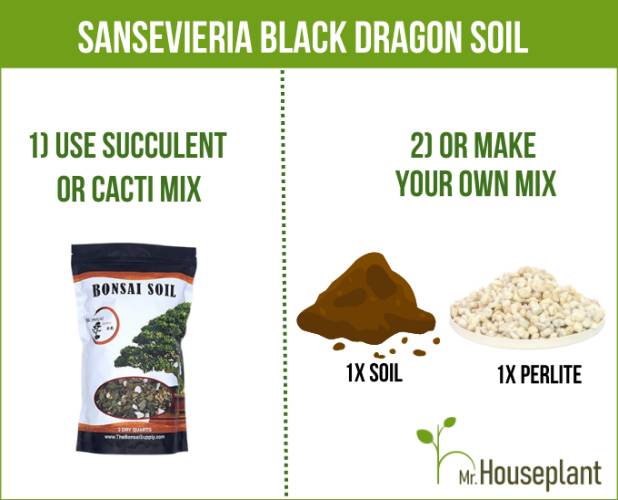
You can buy soil or make it for your plant
Repotting
For Sansevieria Black Dragon repotting follow these steps:
- Take the plant out of its container
- Gently loosen the root ball
- Examine the root ball
- Cut off soft, mushy, and dead roots
- Fill up 1/3 of the new container with fresh soil (pot with drainage holes would be best)
- Place the Sansevieria Black Dragon into the new container
- Fill the pot with soil
- Press the soil gently around the plant
- Wait for the soil to fully dry out before watering
Check out the Black Dragon repotting process in the video below. However, unlike in the following video, amend the soil with perlite:
Toxicity To Humans
Sansevieria Black Dragon is toxic to humans if ingested and can cause diarrhea or vomiting, according to the University of California’s Division of Agriculture and Natural Resources. Also, if you prune the leaves, Snake plant sap can cause skin rash or irritation.
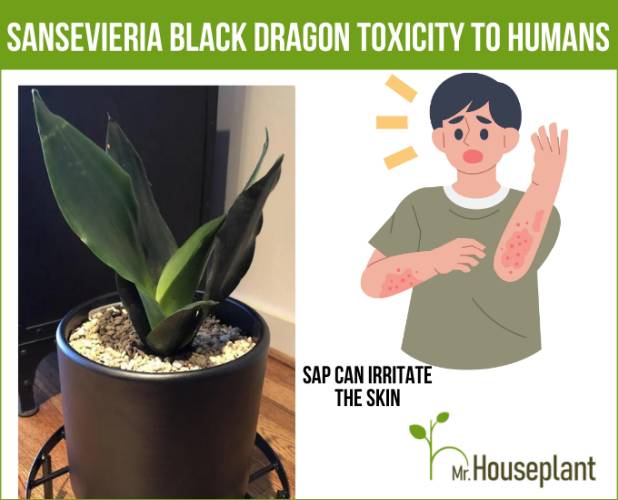
Sansevieria Black Dragon is toxic to humans if ingested and can cause diarrhea or vomiting, according to the University of California’s Division of Agriculture and Natural Resources. Also, if you prune the leaves, Snake plant sap can cause skin rash or irritation.
Toxicity To Pets
Snake plant contains saponin which is mildly toxic to pets if eaten, according to the American Society For Prevention Of Cruelty To Animals (ASPCA). The symptoms are vomiting, diarrhea, severe pain, increased saliva, and nausea.
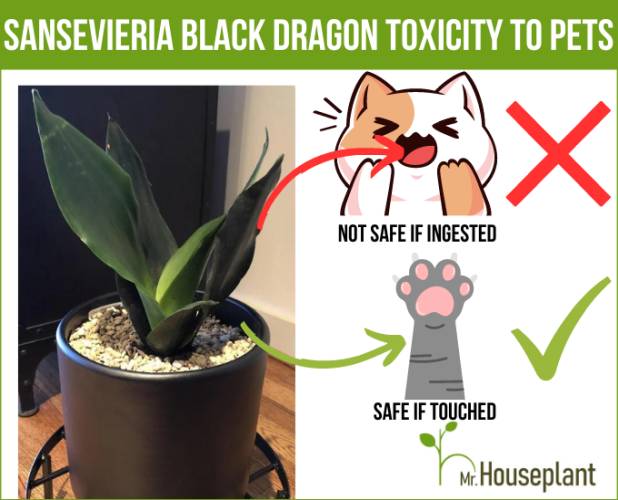
Keep your furry friends away from this plant
Pruning Snake Plants
You don’t need to prune healthy Sansevieria Black Dagon. Prune it if you want to take a cutting for propagation or if there is dead or diseased growth.
Propagation
Propagation methods for Sansevieria Black Dagon plant are through leaf cuttings in water or soil, division and rhizome cuttings. You can also create a Black Dragon through a leaf cutting of Sansevieria Trifasciata ‘Sheri’. Each method is covered below.
Leaf Cutting In Water
Follow these steps to propagate Sansevieria Black Dagon through this method:
- Cut off a whole leaf (or cut off a single leaf into several sections)
- Position the cut leaf in a propagation dish with water. Keep the same leaf orientation. If you turn the leaf upside-down, it will not absorb moisture and will die.
- Place the dish in bright light over 10,000 lux
- Replace the water every week to maintain oxygen and remove damaging bacteria
- If you use an air pump or a heat mat it will speed up water propagation. A heat mat will raise the temperature of the water and speed up the propagation process. An air pump provides oxygen for new roots. It makes the propagation much faster and minimizes the need to replace water.
- Transfer the cuttings to the soil when they develop 2-3 inches of roots
- Water the soil once the soil fully dries out
- In a couple of months to 1 year, you’ll notice new leaves growing

Propagate your plant in 6 simple steps
Leaf Cutting In Soil
Follow these steps to propagate Sansevieria Black Dagon through this method:
- Cut off a whole leaf (or cut off a single leaf into several sections)
- Use a shallow pot and fill it with a well-draining soil mix (1 part soil, 1 part perlite)
- Place the cut leaf in the container (Make sure to keep the same leaf orientation. If you turn the leaf upside-down, it won’t be able to absorb moisture and will die)
- Put the container in a warm spot with a bright light which is over 10,000 lux
- Water it once the soil is completely dry
- If the soil remains wet longer than a couple of days, increase light and repot to a terra cotta pot
- In a couple of months to 1 year, a new leaf will grow
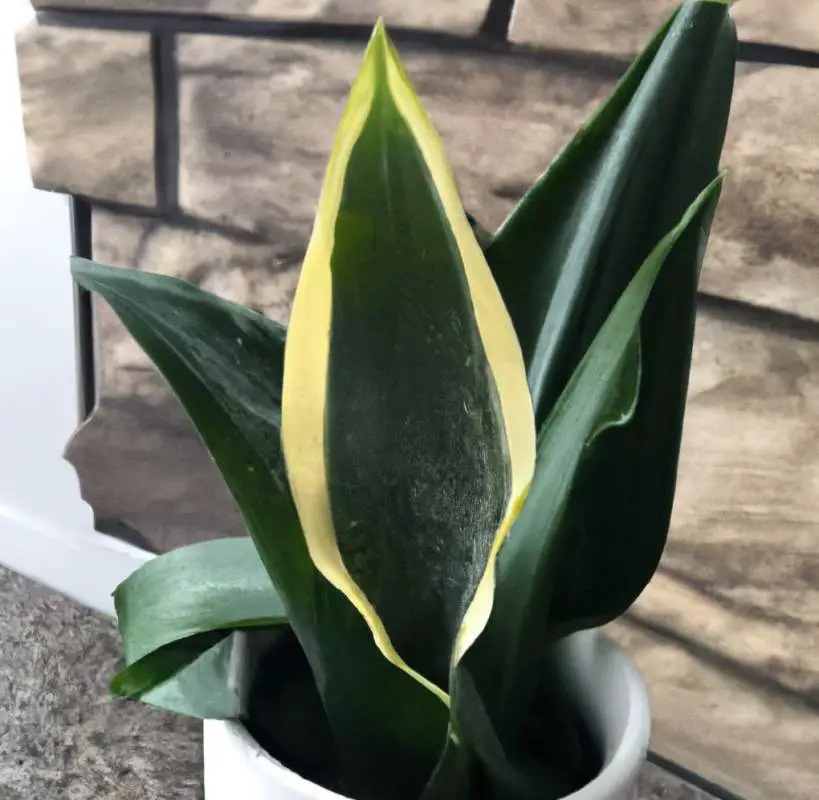
Black Dragon from Sheri propagation. Sansevieria Black Dragon is a drought tolerant plant.
Check out the video below for Black Dragon propagation by leaf cuttings:
Through Division
You can propagate your Sansevieria Black Dragon through division if it has multiple crowns in the container. Division means to separate the two crowns/two plants at the root level and to pot them separately. If you do it, you will get two individual plants. Follow these steps to propagate Sansevieria Black Dagon through this method:
- Take the Sansevieria Black Dragon out of its container
- Remove just enough soil to expose the rhizome connecting the 2 plants
- Take a sterilized knife
- Cut the rhizome in the middle, between the 2 plants. You can also break it off with your hands
- Let the plants sit for 1-2 days so the cut rhizomes dry out
- Now you can pot each plant in a separate pot.
Through Rhizome Cuttings
To propagate Sansevieria Black Dragon you don’t need to cut off its leaves, you can take a piece of the rhizome to create a new plant. Follow these steps to propagate Sansevieria Black Dragon through rhizome cuttings:
- Remove the plant from its pot
- Remove soil so that the rhizomes are exposed (fleshy thick roots)
- Sterilize a knife with rubbing alcohol
- Cut off a piece of the rhizome (the larger the better)
- Let the rhizome sit for a couple of days so the wound can heal
- Place the rhizome in a shallow dish with a well-draining soil mix (1 part soil, 2 parts perlite)
- Keep the container in a warm place
- Water once every 2-4 weeks (make sure the soil is completely dry between waterings and make sure that the soil doesn’t stay moist longer than a week)
- In a few weeks, the rhizome will grow roots
- In a few months to 1 year, it will grow new leaves
The propagation speed and the leaf size depend on the size of the original rhizome cutting. A larger rhizome has more energy and can produce a bigger leaf.
The most important factor in the propagation process is to not keep the rhizome moist for longer than one week. You can prevent this if you use a heat mat. A heat mat raises the temperature of the soil by several degrees. The soil will dry faster, which will reduce the chances of root rot and will help the rhizome develop roots faster.
Leaf Cutting of Sansevieria Trifasciata ‘Sheri’.
When you propagate ‘Sheri’ through a leaf cutting, new plants that grow from the cuttings will not keep the mother plant’s variegation and you will get a Black Dragon plant. Here is how to create a Black Dragon from a ‘Sheri’:
- Cut off a whole leaf (or cut off a single leaf into several sections)
- Pot the cut leaf in the soil. Keep the same leaf orientation. If you turn the leaf upside-down it will not absorb moisture and will die
- Place the pot in bright light over 10,000 lux
- Water once the soil has fully dried out
- In a couple of months to 1 year, you’ll notice new leaves growing from the cutting. The leaves will be dark green, without variegation.
- If you use a heat mat or a grow light to speed up propagation. A heat mat will raise the temperature of the water and speed up the propagation process. A grow light will increase the amount of light and speed up propagation.

This is how the plant looks like when propagated from the plant Sheri
How Long Does It Take To Propagate Black Dragon Snake Plant?
Black Dragon Snake Plant is a slow grower. It takes a few months to one year to propagate it.
Pests
These indoor plants don’t have a lot of pests. The most common are scale and thrips. To treat the scale apply horticultural oil, insecticidal soap, or neem oil. Spray thoroughly topside and underside of all leaves. Repeat as needed.
Thrips are difficult to get rid of. The best way to get rid of thrips is to apply systemic insecticide. Add 1 teaspoon of this insecticide per gallon of water and water the Snake Plant. The plant will absorb insecticide through the water. Since thrips feed on the plant, they will intake the product and die
Spider mites do not usually attack snake plants.
Common Problems
Shriveled Leaves
Shriveled leaves appear on underwatered Snake plants. Water Snake Plants and make sure the soil is completely saturated. In 1-2 days, the leaves should return to regular condition.
Soft and mushy leaves
Overwatering Snake Plants can cause root rot that will lead to soft and mushy leaves. If your Snake Plants have soft and mushy leaves, remove them from their container. Remove all soil and cut off mushy and soft roots. Prepare a fresh well-drained soil mix and repot the Plant. Put your plant in bright spot.
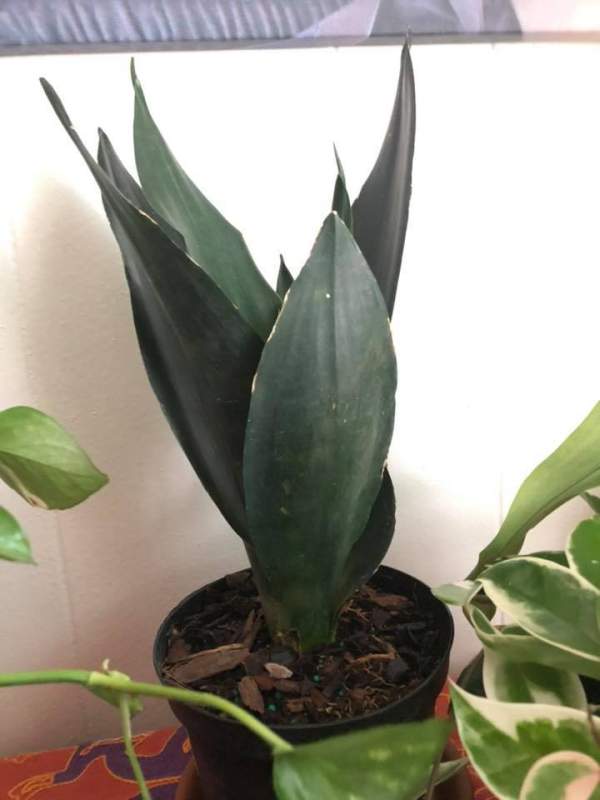
Black Dragon Sansevieria is a drought resistant and beautiful plant with dark green succulent leaves.
Sansevieria Trifasciata Care
If you’re interested in learning more about general Sansevieria Trifasciata care, not just Black Dragon care, check out my detailed blog post about Sansevieria Trifasciata. You will learn about light, watering, fertilizing and all other aspects of Snake plant care.
Conclusion
Sansevieria Trifasciata Black Dragon is a beautiful, easy to care for plant, like most Snake plants. Black Dragon is a name used for Snake plant ‘Future Midnight’, as well as for plants grown through leaf propagation of Sansevieria Trifasciata ‘Sheri’. If you provide it with the proper light and watering, you will have a gorgeous plant for years to come.
Yours Truly,





Thanx 4 these VERY thorough tips of my FAVORITE the Blk Dragon Sansevieria
You’re very welcome AnRo 🙂